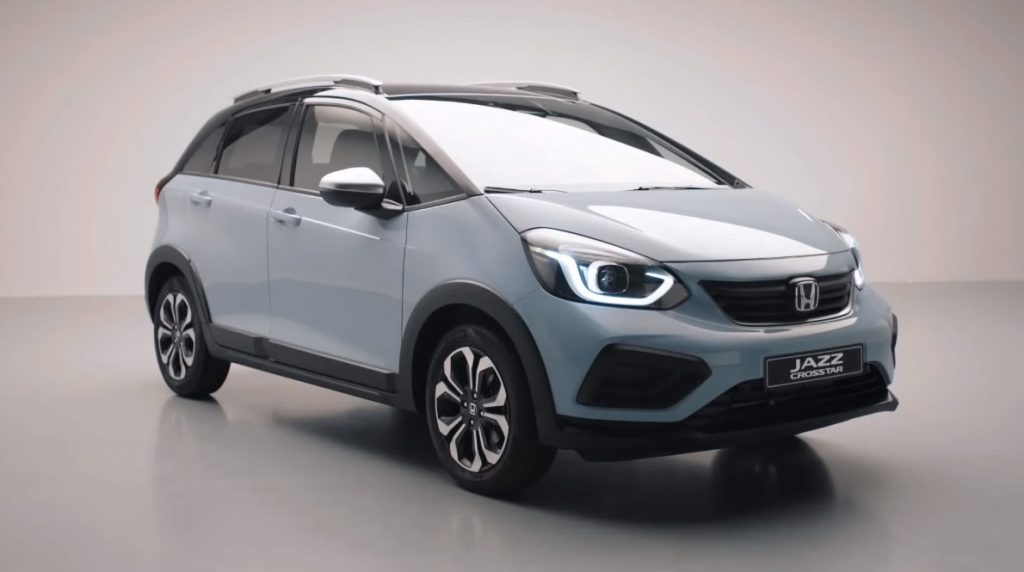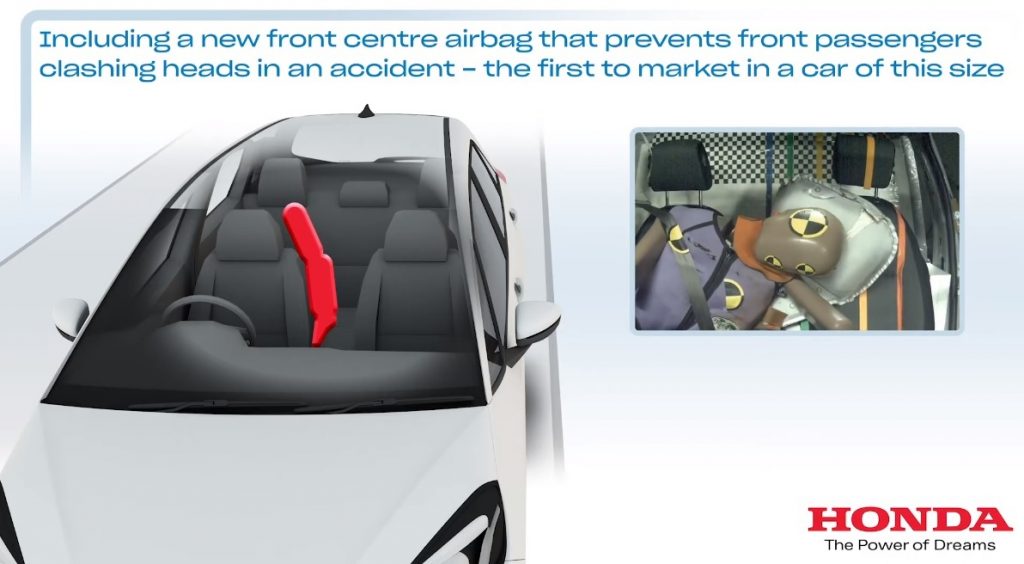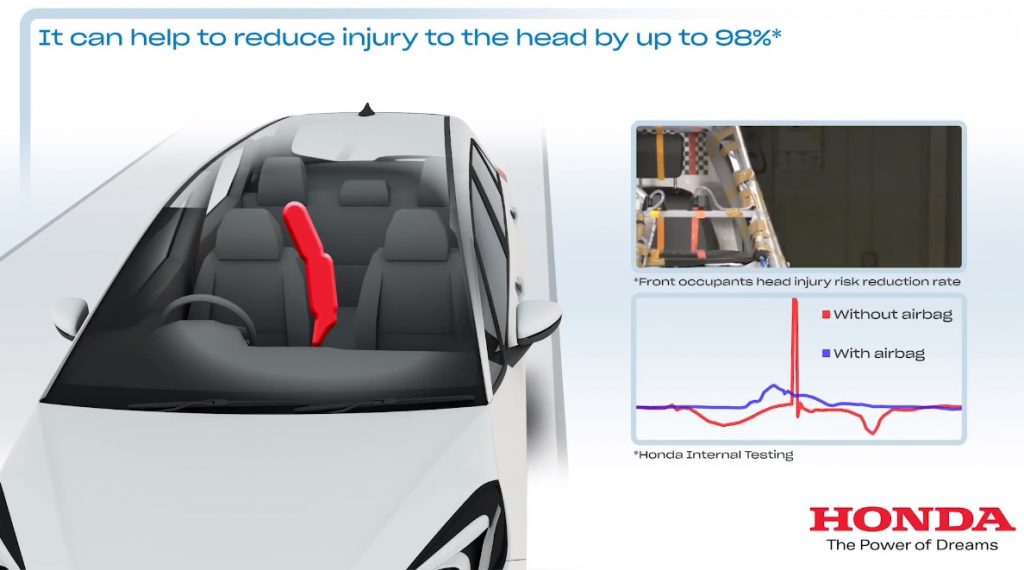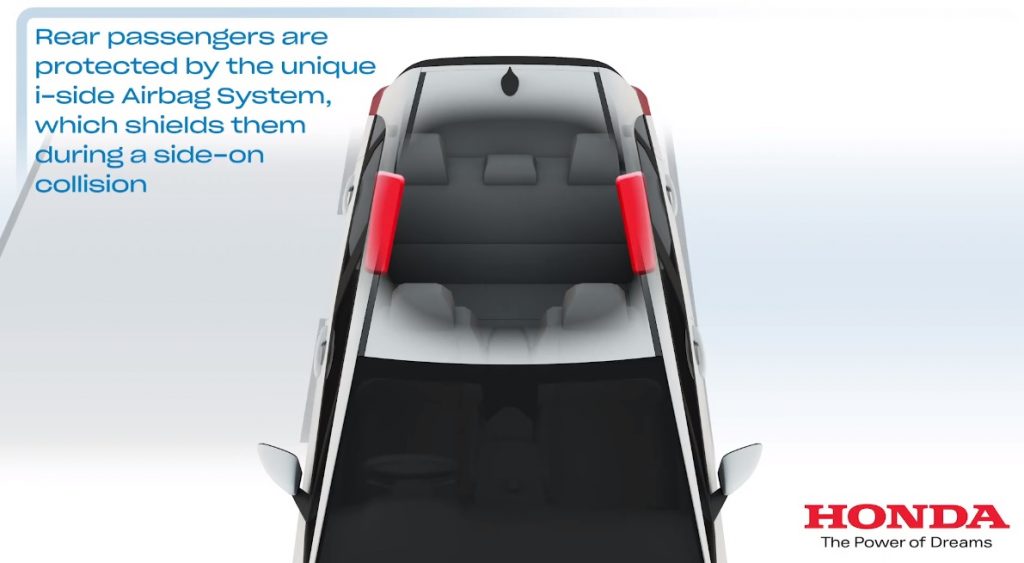Honda equips the Jazz e:HEV with the new, central front airbag technology as standard.
The new technology is one of a number of modifications that reduce the risk of head and chest injuries to passengers in the event of a side impact.
Passive and active safety systems such as the Honda ACE body structure and Honda SENSING technologies and driver assistance systems complement the airbag system.
Honda’s commitment to first class passenger protection continues to make jazz one of the safest vehicles in its class.

In line with Honda’s commitment to protecting all passengers, the new Honda Jazz is the brand’s first model on the European market – as well as the first model in its class – with central front airbag technology as standard. This newly launched passive safety system is just one element of comprehensive safety technologies and driver assistance systems that live up to Jazz’s reputation as one of the safest vehicles on the European market.
New central front airbag system
The new central front airbag is located in the backrest of the driver’s seat and covers the area between the driver and front passenger. It is one of a total of 10 airbags in the new Jazz and helps to reduce the force of a direct collision between the driver and front passenger in the event of a side impact.

To ensure that the airbag is optimally positioned and offers maximum protection when triggered, three guide belts are used to guide the airbag around the driver. To implement this new function, the development team integrated the airbag into the upper back cushion of the newly designed driver’s seat.

In addition to the central front airbag, two additional safety functions are used in the event of a side impact. The belt tensioners for the driver and front passenger reduce the lateral movements of the passengers and are supported by the now higher center armrest. Thanks to this new concept, head injuries to the driver and front passenger can be reduced by 85% on the impact side and by 98% on the side facing away from the impact (Honda internal test data).
Another improvement in the new Jazz are the i-side airbags at the rear. The unique double-structure airbag integrated in the upholstery of the rear seats protects the rear passengers from a collision with the door or the C-pillar in the event of a side impact. The airbag is so compact that the unique Magic Seats function of jazz is retained.

These further developments in passenger safety correspond to the new Euro NCAP test guidelines 2020 for evaluating vehicle safety in order to take account of the serious consequences of side collisions. The new assessment will further expand the scope of investigations of the consequences of a side impact on the rear area of the vehicle.
“Passenger safety is a key focus of Honda engineers when developing a new vehicle,” said Takeki Tanaka, Honda Large Project Leader. “The new Jazz has been completely redesigned and is equipped with the latest and most advanced structural technologies as well as the latest passive safety technologies to offer the best possible protection in all accident scenarios. With the revised range of standard modern safety technologies and driver assistance systems, we are convinced that the new Jazz will continue to be one of the safest vehicles in its class in the future.”
The SRS knee airbag on the driver’s side, which is integrated in addition to the central front airbag, provides better protection for the lower limbs in the event of an impact and also contributes to increased safety in the head and chest area by suppressing the forward movement of the entire body.
Passive safety through ACE body structure
In the area of passive safety, the new Jazz features the ACE ™ body structure (Advanced Compatibility Engineering ™) for improved passenger protection.
A frame made of connected structural elements ensures a more even distribution of the impact energy in the front area of the vehicle and thus reduces the forces that are transmitted to the passenger compartment. The body also offers special safety when vehicles with different heights, frame construction or different weights meet head-on.
Improved active safety technologies as standard equipment
The passive safety systems of the new Jazz are supplemented by the Honda SENSING active safety and driver assistance systems, which have been expanded for the new model. The new high-resolution wide-angle camera replaces the previous multifunctional camera and the City Emergency Brake Assist (CTBA) from the previous model. The new camera recognizes a wide variety of road surfaces and traffic situations. This includes a warning system, which is activated as soon as the vehicle approaches the edge of the road (grass or gravel strips), the distance to an oncoming vehicle becomes too short, or the vehicle changes lanes without the turn signal set, and the traffic sign recognition. In addition, the camera reduces fogging and ensures a clear view.
The comprehensive Honda SENSING safety technologies include:
- Collision warning system with active brake intervention and pedestrian detection (Collision Mitigation Braking System): Prevents collisions with other vehicles or pedestrians; improved performance in the dark to detect pedestrians and cyclists in the absence of street lighting; also brakes automatically on oncoming or turning vehicles. This is made possible by the newly developed high-resolution wide-angle front camera.
- Adaptive Cruise Control: Allows you to set and maintain a desired speed and distance from the vehicle in front.
- Active Lane Keeping Assist System: keeps the vehicle in the middle of the lane on city and country roads as well as on multi-lane motorways; active from 72 km / h.
- Lane departure warning system (Road Departure Mitigation System): Detects the lane boundaries and supports the driver in staying on the lane.
- Traffic Sign Recognition: Automatic recognition of traffic signs using the wide-angle camera and display on the 7-inch LCD display. The system displays up to two signs at the same time – the speed limit is shown on the right, overtaking bans on the left or speed limits with additional information such as B. Weather conditions.
- Intelligent Speed Limiter: Automatically adjusts the speed to the current speed limit detected by traffic sign recognition or to the driver’s setting. When the limit is reached, a warning light flashes and the speed is reduced.
- High-beam assistant: Detects vehicles in front and oncoming vehicles and automatically switches between low and high beams.
- Blind spot assistant including parking assistant as standard in the Executive equipment variant.









